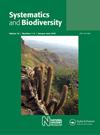Contribution to the lady beetle fauna of the Yucatan Peninsula and integrative taxonomy for species delimitation
IF 2
3区 环境科学与生态学
Q2 BIODIVERSITY CONSERVATION
引用次数: 1
Abstract
Lady beetles (Coleoptera: Coccinellidae) are among the most familiar insects; many species are of economic importance, but their diversity in the tropics is poorly known. We aimed to contribute to the knowledge of the lady beetle fauna of the Yucatan Peninsula, particularly for Quintana Roo state. We used an integrative approach for species identification, comparing classical morphological identifications and quick automated methods for species delimitation using DNA barcode sequences. Through a literature review and a survey of lady beetles in gardens in Quintana Roo, we further provide an updated list of the species found on the Yucatan Peninsula. Out of the 40 species delimited in our study, 34 are new reports for the peninsula, and 36 are new for Quintana Roo state. Overall, 62 species of lady beetles are now recorded for the entire region, including three exotics: the invasive Harmonia axyridis, Chilocorus nigrita, and Delphastus catalinae. Our study also contributed to public reference libraries with 110 barcode sequences for the tropics belonging to 34 delineated species. We showed that cytochrome oxidase 1 (COI) sequences can be useful for lady beetle species delimitation and that the Automatic Barcode Gap Discovery algorithm (ABGD) was the best method, complementing the number of initially delineated morphospecies. The Barcode Index Number (BIN) approach overestimated seven putative species due to the splitting of conspecifics, while the ABGD method suggested two additional MOTUs at a prior intraspecific distance of 0.059. Combined molecular and morphological data in our study revealed one additional putative species of Diomus, initially considered a tentative colour variation. Our study exemplifies how molecular methods paired with classical taxonomy can efficiently assist in delineating species when descriptions and identification keys are unavailable and highlights the possible great richness of coccinellid species awaiting exploration and description on the Yucatan Peninsula.对尤卡坦半岛瓢虫区系的贡献和物种划界的综合分类学
瓢虫(鞘翅目:瓢虫科)是最常见的昆虫之一;许多物种具有重要的经济意义,但它们在热带地区的多样性却鲜为人知。我们的目标是为尤卡坦半岛,特别是金塔纳罗奥州的瓢虫动物群的知识做出贡献。我们使用了一种综合的物种识别方法,比较了经典的形态学识别和使用DNA条形码序列进行物种划界的快速自动化方法。通过文献综述和对金塔纳罗奥花园中瓢虫的调查,我们进一步提供了尤卡坦半岛发现的最新物种列表。在我们的研究中划定的40个物种中,34个是半岛的新报告,36个是金塔纳罗奥州的新报告。目前,整个地区共记录了62种瓢虫,其中包括三种外来物种:入侵性异色谐波甲虫、黑Chilocorus nigrita和卡塔利娜Delphastus catalinae。我们的研究还为公共参考图书馆提供了110个热带条形码序列,属于34个划定的物种。我们发现细胞色素氧化酶1(COI)序列可用于瓢虫物种的划界,自动条形码间隙发现算法(ABGD)是最好的方法,补充了最初划定的形态物种的数量。条形码索引号(BIN)方法高估了7个假定物种,因为同种的分裂,而ABGD方法建议在之前0.059的种内距离处增加两个MOTU。在我们的研究中,结合分子和形态学数据,揭示了另一种Diomus的假定物种,最初被认为是一种暂时的颜色变化。我们的研究举例说明了当描述和识别密钥不可用时,分子方法与经典分类学相结合如何有效地帮助描述物种,并强调了尤卡坦半岛上等待勘探和描述的球虫物种可能非常丰富。
本文章由计算机程序翻译,如有差异,请以英文原文为准。
求助全文
约1分钟内获得全文
求助全文
来源期刊

Systematics and Biodiversity
环境科学-生物多样性保护
CiteScore
4.10
自引率
0.00%
发文量
46
审稿时长
>24 weeks
期刊介绍:
Systematics and Biodiversity is devoted to whole-organism biology. It is a quarterly, international, peer-reviewed, life science journal, without page charges, which is published by Taylor & Francis for The Natural History Museum, London. The criterion for publication is scientific merit. Systematics and Biodiversity documents the diversity of organisms in all natural phyla, through taxonomic papers that have a broad context (not single species descriptions), while also addressing topical issues relating to biological collections, and the principles of systematics. It particularly emphasises the importance and multi-disciplinary significance of systematics, with contributions which address the implications of other fields for systematics, or which advance our understanding of other fields through taxonomic knowledge, especially in relation to the nature, origins, and conservation of biodiversity, at all taxonomic levels.
The journal does not publish single species descriptions, monographs or applied research nor alpha species descriptions. Taxonomic manuscripts must include modern methods such as cladistics or phylogenetic analysis.
 求助内容:
求助内容: 应助结果提醒方式:
应助结果提醒方式:


